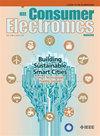乳腺癌细胞系识别:用排斥性位阻方法建模和模拟
IF 4.3
2区 计算机科学
Q1 ENGINEERING, ELECTRICAL & ELECTRONIC
引用次数: 0
摘要
本文详细介绍了高灵敏度双金属in0.53 ga0.47 as /Si异质结无掺杂扩展栅bio - htfet (DM-DL-EG-Bio-HTFET)对乳腺癌细胞系(HTB-126、HTB-26、MCF-7和T-47D)的早期检测。利用Silvaco ATLAS TCAD设备模拟器开发并评估了该结构的分析建模。投影模型可能的制作框架在这里被描绘。优化器件布局参数,考虑Ga的摩尔分数和扩展栅极长度,以达到更好的效果。提出空间效应的排斥性是为了避免假设评价与实际结果之间的偏差。器件静电以及所提供的Bio-HTFET的传感演示和RSE对电特性的影响进行了探讨。对于介电常数为32.2的T-47D类乳腺癌细胞株,实现了最佳的ON-to-OFF电流灵敏度(${\ mathm {S}}_{\text {Ion/Ioff}}$)为$18.6\ × 10{^{{6}}}$,平均亚阈值振荡灵敏度(SSSA)为93%。Benchmarking准备对推荐的Bio-HTFET提供可量化的评估,并提供最近报道的文章,以突出其效率。在不考虑RSE的情况下,估计所得电容的最大误差为41%。因此,RSE需要在生物传感研究中纳入,以使其普遍可行。本文章由计算机程序翻译,如有差异,请以英文原文为准。
Breast-Cancer Cell Lines Recognition: Modeling and Simulation With Repulsive Steric Hindrance Approach
Early detection of breast-cancer cell lines (HTB-126, HTB-26, MCF-7, and T-47D) reliant on double-metalIn0.53Ga0.47As/Si hetero-junctioned dopingless expanded gate Bio-TFET (DM-DL-EG-Bio-HTFET)with enormous sensitivity is specified in this manuscript. Analytical modeling for the configuration has been developedand assessed with Silvaco ATLAS TCAD device simulator. Possible fabrication framework of the projected model is portrayedhere. Optimization of device layout parameters concerning molar fraction of Ga and expanded gate length is performed toachieve superior efficacy. The repulsive nature of steric effect (RSE) is initiated to evade the deviations among the hypothetical evaluations and practical results. Device electrostatics along with the sensing presentations of the offered Bio-HTFET and the impact of RSE on electrical features is explored. A best possible ON-to-OFF current sensitivity ( ${\mathrm {S}}_{\text {Ion/Ioff}}$ ) of $18.6\times 10{^{{6}}}$ with average sub-threshold swing sensitivity (SSSA) of 93% are realized for T-47D category breast-cancer cell line with permittivity 32.2. Benchmarking isprepared to offer a quantifiable evaluation of the recommended Bio-HTFET with recently reported articles to spotlight itsefficiency. An utmost 41% inaccuracy in resultant capacitance is estimated devoid of considering RSE. Hence, RSE needs to be incorporated during biosensing investigations to create it generally realistic.
求助全文
通过发布文献求助,成功后即可免费获取论文全文。
去求助
来源期刊
CiteScore
7.70
自引率
9.30%
发文量
59
审稿时长
3.3 months
期刊介绍:
The main focus for the IEEE Transactions on Consumer Electronics is the engineering and research aspects of the theory, design, construction, manufacture or end use of mass market electronics, systems, software and services for consumers.

 求助内容:
求助内容: 应助结果提醒方式:
应助结果提醒方式:


